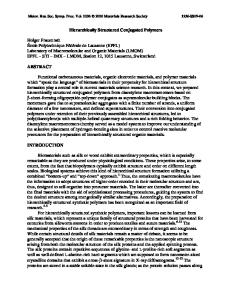Steady State Photoconductivity in Conjugated Polymers
- PDF / 49,369 Bytes
- 5 Pages / 612 x 792 pts (letter) Page_size
- 58 Downloads / 351 Views
Steady State Photoconductivity in Conjugated Polymers C. D. Sitch, D. P. Halliday and A. P. Monkman Organic Electroactive Materials Research Group, Department of Physics, University of Durham, South Road, Durham. DH1 3LE. UK. ABSTRACT Visible and ultraviolet photoconductivity (PC) measurements have been performed on thick (7µm) and thin (170nm) films of poly[2-methoxy, 5 ethyl (2’ hexyloxy) paraphenylenevinylene] (MEH-PPV) sandwiched between indium tin oxide (ITO) and semitransparent gold (Au) electrodes. PC spectra were obtained for samples under different bias polarities and for illumination through the ITO electrode and through the Au electrode. The results obtained indicate that the absorbed photons form excitons that dissociate extrinsically at or near the electrodes to form hole polarons or intrinsically at higher photon energies in the bulk polymer.
INTRODUCTION The use of conjugated polymers as the active layer in polymeric light emitting diodes is well documented [1-5]. The use of photoconductivity to determine the nature of optical charge generation and transport in conjugated polymers is an active area of research [6-10]. It is accepted that the absorption of photons in conjugated polymer produces excitons. These excitons may dissociate at or near the electrodes to form charge carriers (polarons), however, only high mobility polarons will be able to contribute to the photocurrent. The polaron species with the greater mobility (electron or hole polaron) is polymer dependent. Extrinsic dissociation depends on which electrode is being illuminated with respect to bias polarity. This is understood in terms of the symbatic and antibatic response of the photocurrent spectra with respect to the absorption spectra of the polymer. The process of intrinsic dissociation of excitons is still under debate. Charge transport is believed to occur via hopping[11, 12].
EXPERIMENTAL DETAILS Films of MEH-PPV were either spin coated (for thin films) or drop cast (for thick films) from solution onto ITO coated glass substrates. Semitransparent Au layers (20nm) were evaporated onto the MEH-PPV to complete the sample. Stationary photoconductivity measurements were taken by applying a bias to the sample and measuring the dark current. The sample was illuminated using a monochromated xenon arc lamp and the photocurrent measured. The sample was then short circuited and illuminated with 1.6eV photons for 30 seconds then left in the dark for 5 minutes to allow charge detrapping. This was done for each point. The results were normalised for the absorption and reflection of the electrodes, the output of the lamp and the monochromator throughput using an ultraviolet enhanced silicon photodiode.
C8.17.1
DISCUSSION
Absorbance (arb. units)
Photocurrent (arb. units)
Figure 1 shows the photocurrent spectra for illumination through the Au electrode of the thin film MEH-PPV sample. Figure 2 shows the photocurrent spectra for illumination through the ITO electrode of the thin film MEH-PPV sample. The MEH-PPV film for the thin film sample
Data Loading...











